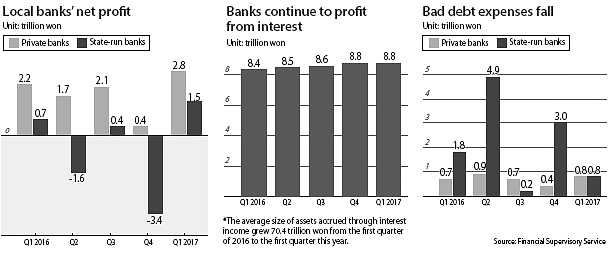Profit at Korean banks reaches a six-year high

Korean banks’ net profit for the first quarter of 2017 reached 4.3 trillion won ($3.81 billion), a 49 percent jump compared to the same period last year, according to the data released by the Financial Supervisory Service. The quarterly profit is the highest since 2011 when banks posted a 4.5 trillion won net profit.
The non-interest income of the banks also showed tremendous growth.
Non-interest income, generated from various sources such as commissions and foreign exchange trading, jumped 88.4 percent from 1.3 trillion won in 2016 to 2.5 trillion won during the same period in 2017. Korean banks have been trying to shift their reliance on loan interest to other sources of revenue to fend off the risks stemming from the issuance of loans. Although the quarterly non-interest income looks promising, the FSS said it was temporary profit such as from the sale of loans that contributed to the change.
The increase may have been comparably low but interest revenue continued to be a key profit source for the banks.
Banks raked in 8.8 trillion won during the first three months of this year, 400 billion won, or 4.3 percent, more than the same period in 2016.
Interest income of local banks nosedived after the 2008 financial crisis, from nearly 9.3 trillion won in the fourth quarter of 2008 to 6.4 trillion won by the second quarter of 2009. It quickly recovered, however, reaching 9.7 trillion won in the first quarter of 2012. Since then, the interest income from the industry has never fallen below 8 trillion won. “This seems inevitable given the structure of the industry,” said an FSS official.
Another contributor to the rise in profit was the notable change in costs related to bad loans.
The banking industry’s quarterly bad debt expense, the amount of uncollected receivables, was 2.5 trillion won in the first quarter of 2016. This number, however, fell to 1.5 trillion won this year. In particular, state-run banks were able to slash the expense from 1.8 trillion won to 800 billion won.
“A large sum of bad debt expenses occurred during the first quarter of 2016 due to a crisis involving the local shipping industry as well as STX Heavy Industries,” said the FSS official, who said a corporate restructuring often takes a toll on banks’ profit.
BY CHOI HYUNG-JO [choi.hyungjo@joongang.co.kr]










with the Korea JoongAng Daily
To write comments, please log in to one of the accounts.
Standards Board Policy (0/250자)